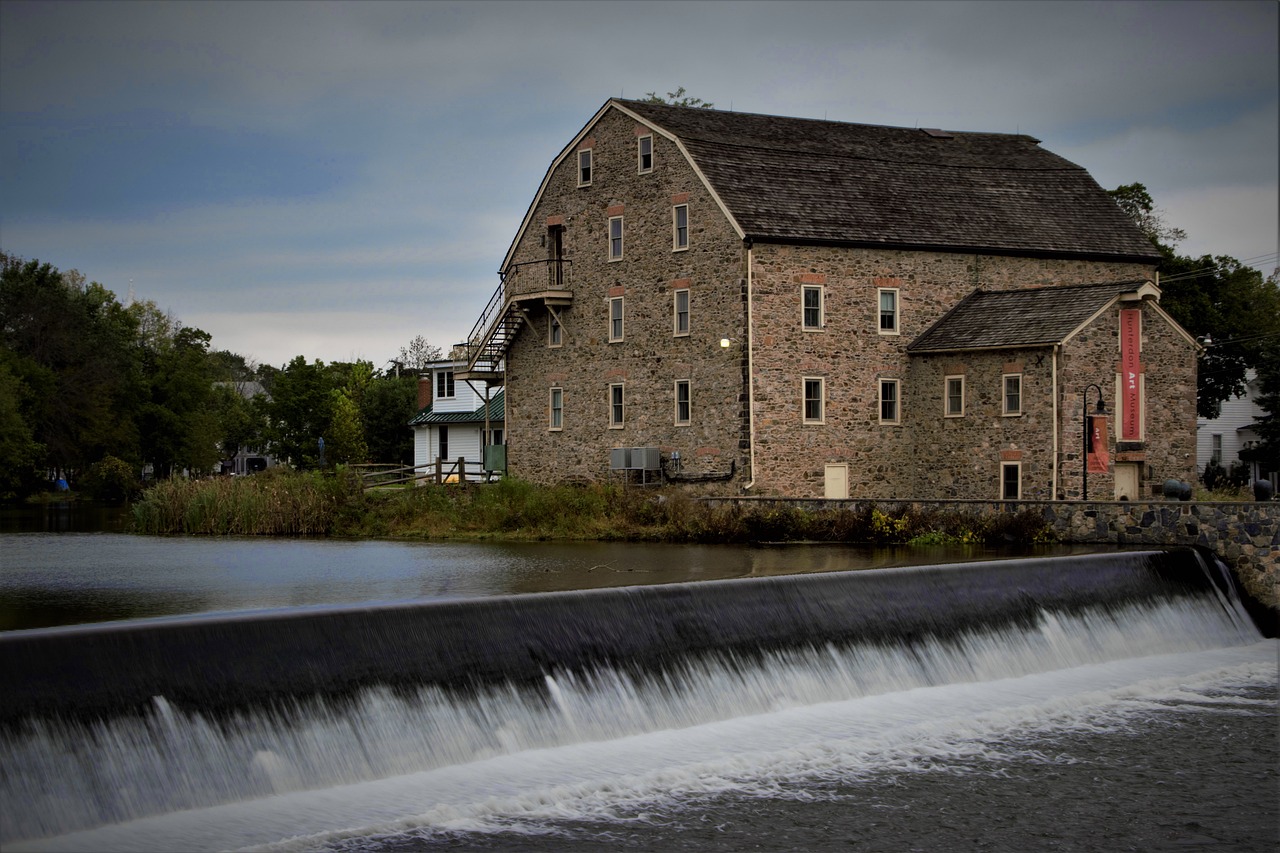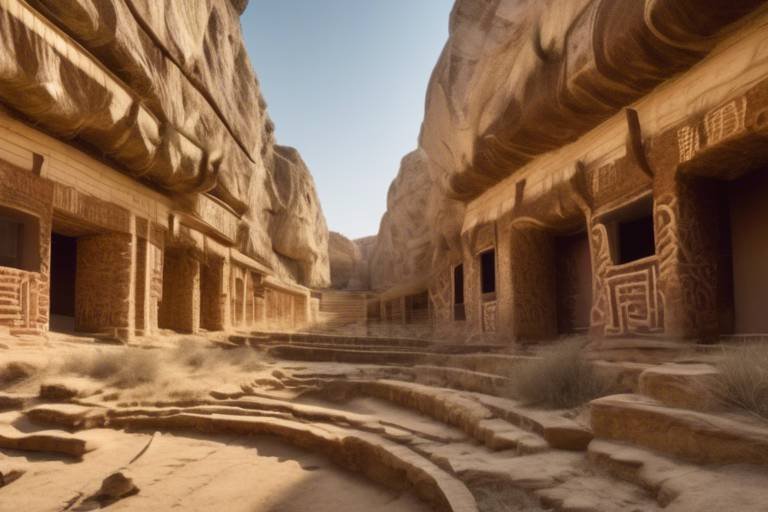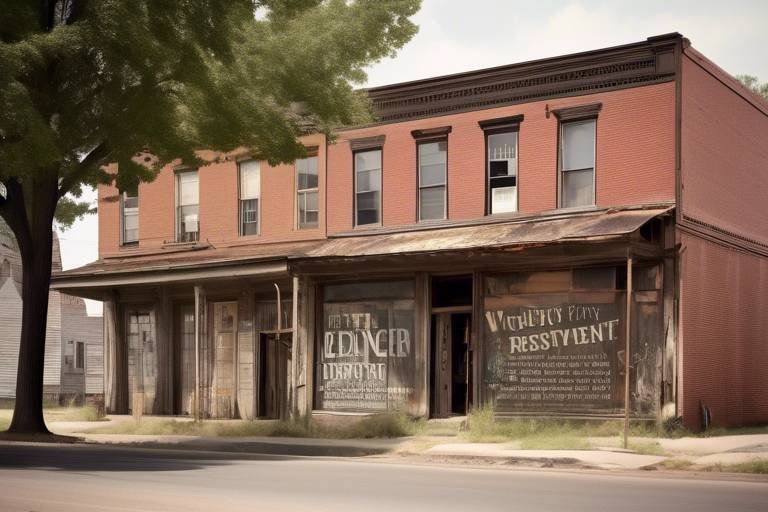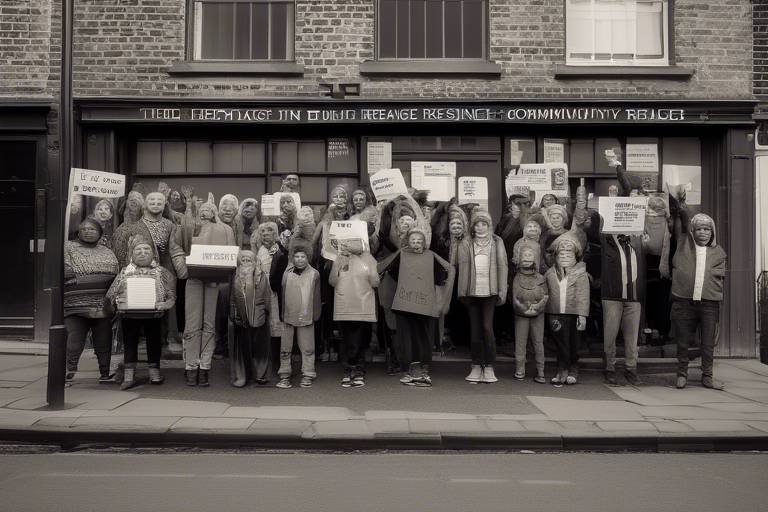Exploring the Role of Historic Preservation Commissions
Historic preservation commissions play a vital role in safeguarding our cultural heritage and architectural legacy. These commissions are entrusted with the responsibility of preserving and protecting significant historical structures and sites for future generations to appreciate and learn from. By delving into the functions and impact of historic preservation commissions, we can gain a deeper understanding of their crucial role in maintaining the fabric of our communities.

History of Preservation Commissions
Historic preservation commissions play a crucial role in safeguarding our cultural heritage and architectural treasures. Let's delve into the various aspects that define and shape the functions of these commissions.
Historic preservation commissions have a rich history dating back to the early 20th century when the preservation movement gained momentum in response to rapid urban development and the threat of losing significant historical sites. These commissions were established to protect and conserve buildings, landmarks, and neighborhoods that hold cultural and historical importance. Over time, their mandate expanded to include a broader range of preservation activities, such as designating historic districts and landmarks, reviewing development proposals, and promoting heritage education.

Legal Framework and Guidelines
When delving into the realm of historic preservation commissions, one must first grasp the intricate web of legal frameworks and guidelines that serve as the backbone of their operations. These commissions operate within a structured framework of laws, regulations, and guidelines that dictate their decision-making processes and preservation efforts.
At the core of these legal structures lies the National Historic Preservation Act, a landmark piece of legislation enacted in 1966. This federal law established the National Register of Historic Places and the State Historic Preservation Offices, laying the groundwork for the formation of local preservation commissions.
Furthermore, many states have their own set of laws and regulations that govern historic preservation activities at the local level. These statutes often outline the procedures for designating historic landmarks, obtaining permits for alterations or demolitions, and providing incentives for property owners to preserve historic structures.
Historic preservation commissions are guided by preservation guidelines that help assess the historical significance of buildings and structures, determine appropriate conservation methods, and ensure compliance with preservation standards. These guidelines serve as a compass, steering the commissions through the intricate process of safeguarding cultural heritage.
Moreover, the Secretary of the Interior's Standards for Rehabilitation play a pivotal role in shaping preservation efforts by providing a set of principles for maintaining the historic character of buildings while accommodating modern needs. Adhering to these standards is crucial for ensuring the authenticity and integrity of preserved structures.
In addition to legal frameworks and guidelines, historic preservation commissions often collaborate with local planning departments and zoning boards to navigate the complex landscape of land use regulations and development proposals. This collaborative approach ensures that preservation goals are integrated into broader community planning initiatives.

Community Engagement and Advocacy
Community engagement and advocacy play a crucial role in the success of historic preservation commissions. These commissions rely on the active participation of local residents, historical societies, and advocacy groups to promote the preservation of cultural heritage and architectural landmarks. By engaging with the community, preservation commissions can raise awareness about the importance of protecting historical sites and garner support for their initiatives.
One of the primary ways in which communities can engage with preservation commissions is through public meetings and hearings. These forums provide opportunities for residents to voice their opinions, express concerns, and contribute ideas regarding preservation projects in their neighborhoods. Community input is instrumental in shaping the decisions made by preservation commissions, ensuring that the interests and values of the local population are taken into account.
Furthermore, advocacy plays a vital role in mobilizing support for preservation efforts. Community members and organizations can advocate for the protection of historic sites by raising awareness through social media campaigns, organizing fundraising events, and lobbying local government officials. By advocating for the preservation of cultural heritage, communities can safeguard their unique identity and promote a sense of pride and belonging among residents.
In addition to direct engagement with the community, preservation commissions can also collaborate with educational institutions, museums, and cultural organizations to promote awareness and appreciation of local history. By partnering with schools to develop educational programs or hosting cultural events and exhibitions, preservation commissions can engage a wider audience and foster a deeper connection to the heritage of the community.
Overall, community engagement and advocacy are essential components of the work carried out by historic preservation commissions. By involving the community in preservation efforts and advocating for the protection of cultural heritage, these commissions can ensure the continued appreciation and conservation of historical landmarks for future generations to enjoy.

Economic Impact of Preservation Efforts
Historic preservation commissions play a vital role in safeguarding our cultural heritage and architectural treasures. These entities are tasked with preserving the historical integrity of our communities, ensuring that the stories of the past are not lost to the relentless march of time.
When it comes to historic preservation efforts, the impact goes far beyond just maintaining old buildings. These endeavors have a significant economic ripple effect that can revitalize neighborhoods and boost tourism. By preserving historic structures, communities can attract visitors who are eager to experience the charm and character of a bygone era.
Moreover, historic preservation projects can lead to job creation and stimulate local economies. When old buildings are restored and repurposed, new businesses can flourish, creating a vibrant and dynamic environment that benefits everyone in the community.
However, it's essential to acknowledge the challenges that come with preservation efforts. Restoring historic buildings can be a costly endeavor, requiring careful planning and financial resources. Balancing the need for preservation with economic considerations is a delicate dance that historic preservation commissions must navigate.
Despite these challenges, the long-term economic benefits of preservation efforts are undeniable. By investing in our cultural heritage, we not only preserve the past but also lay the foundation for a prosperous future.
1. What is the role of historic preservation commissions in protecting cultural heritage?
Historic preservation commissions are responsible for identifying and safeguarding historic sites, buildings, and districts to ensure their preservation for future generations.
2. How do historic preservation efforts contribute to the local economy?
Preservation projects can stimulate economic growth by attracting tourists, creating jobs, and revitalizing neighborhoods, ultimately leading to increased property values and business opportunities.
3. What are some common challenges faced by historic preservation commissions?
Challenges include balancing development interests with heritage conservation, securing funding for preservation projects, and navigating regulatory hurdles to ensure compliance with preservation guidelines.
4. How can individuals support the work of historic preservation commissions?
Individuals can get involved by volunteering, advocating for preservation initiatives, attending public meetings, and staying informed about local preservation efforts.

Challenges and Controversies
Historic preservation commissions play a vital role in safeguarding our cultural heritage and architectural legacy, but they are not without their share of challenges and controversies. One of the primary issues faced by these commissions is the delicate balance between development interests and heritage conservation. As communities grow and evolve, the pressure to accommodate new construction and development projects often conflicts with the need to preserve historic buildings and landmarks.
This tug-of-war between progress and preservation can lead to heated debates and ethical dilemmas within preservation commissions. Members must navigate through competing interests, considering the economic benefits of development while also honoring the historical significance of the past. This balancing act requires careful deliberation and thoughtful decision-making to ensure the best outcomes for both present and future generations.
Another challenge faced by historic preservation commissions is the limited resources available for preservation efforts. Maintaining and restoring historic structures require significant financial investments, and securing funding can be a constant struggle. Preservation commissions often rely on grants, donations, and public support to carry out their mission, making financial sustainability a pressing concern.
Furthermore, controversies can arise when the community is divided on the value of preserving certain buildings or districts. Conflicting opinions on what constitutes historical significance and the extent to which preservation should take precedence over development can lead to heated debates and resistance to preservation efforts. In such cases, preservation commissions must engage in transparent communication and community outreach to build consensus and address concerns.
Moreover, the rapid pace of urban development and the pressures of gentrification pose additional challenges to historic preservation efforts. As neighborhoods undergo rapid transformation, historic buildings may be at risk of demolition or neglect, threatening the integrity of the community's heritage. Preservation commissions must proactively address these issues by advocating for policies that balance growth with preservation and by fostering partnerships with stakeholders to protect historic assets.
In navigating these challenges and controversies, historic preservation commissions must remain steadfast in their commitment to preserving our shared history and architectural legacy. By engaging with the community, advocating for sustainable development practices, and leveraging technological innovations, preservation commissions can overcome obstacles and ensure that our cultural heritage endures for future generations to appreciate and cherish.

Technological Innovations in Preservation
Technological innovations have significantly transformed the field of historic preservation, empowering preservation commissions with advanced tools to document, analyze, and conserve cultural heritage sites. One of the groundbreaking technologies revolutionizing preservation efforts is 3D scanning, which allows for the creation of detailed digital replicas of historical structures with remarkable accuracy. These digital models not only aid in the preservation of architectural details but also serve as valuable resources for research and educational purposes.
In addition to 3D scanning, digital mapping technologies have become essential assets for preservation commissions in mapping out heritage sites, monitoring changes over time, and creating virtual tours for public engagement. By leveraging geographic information systems (GIS) and aerial imaging, preservationists can gain a comprehensive understanding of the historical context and spatial relationships within a site, facilitating informed decision-making in conservation projects.
Furthermore, the integration of augmented reality (AR) and virtual reality (VR) technologies has opened up new possibilities for immersive experiences in heritage preservation. Through AR applications, visitors can explore virtual reconstructions of historical sites overlaid onto the physical environment, offering a unique blend of past and present perspectives. Similarly, VR simulations enable users to virtually walk through ancient ruins or restored buildings, fostering a deeper appreciation for cultural heritage and architectural significance.

Case Studies of Successful Preservation Projects
When it comes to historic preservation projects, success stories can serve as inspiration for communities looking to protect and celebrate their cultural heritage. These case studies highlight the dedication and innovation of historic preservation commissions in safeguarding significant landmarks and revitalizing neighborhoods.
One notable example is the restoration of the Ellis Island Immigration Museum in New York City. The project, overseen by the National Park Service and supported by various preservation organizations, transformed the deteriorating buildings into a world-class museum that tells the story of millions of immigrants who passed through Ellis Island. Through meticulous restoration and adaptive reuse, the museum now stands as a symbol of America's immigrant history.
In Savannah, Georgia, the Historic Savannah Foundation successfully saved the Lucas Theatre for the Arts from demolition. By collaborating with local businesses, donors, and the city government, the foundation raised funds to restore the historic theater to its former glory. Today, the Lucas Theatre serves as a cultural hub for the community, hosting performances and events that enrich the city's artistic landscape.
Another remarkable preservation project is the Rehabilitation of the Historic District in Charleston, South Carolina. The city's strict preservation guidelines, enforced by the Barbados Historic Preservation Commission, have ensured that the architectural integrity of the district is maintained. This commitment to preserving the unique character of Charleston has not only attracted tourists but also increased property values and stimulated local businesses.
Furthermore, the Preservation Resource Center of New Orleans played a crucial role in the restoration of the Garden District Cottages. By providing technical assistance, advocacy, and educational programs, the center empowered homeowners to preserve the historic charm of their properties while enhancing the overall aesthetic appeal of the neighborhood.
These case studies demonstrate the positive impact that strategic planning, community engagement, and partnerships can have on the success of historic preservation projects. By celebrating these achievements, we can inspire future generations to continue the legacy of preserving our cultural heritage for years to come.

Future Trends and Sustainability
The future of historic preservation commissions is intricately tied to sustainability, both in terms of cultural heritage and environmental impact. As we look ahead, several key trends are emerging that will shape the direction of preservation efforts and ensure the long-term viability of our shared history.
One significant trend is the growing focus on sustainability in preservation practices. Preservation commissions are increasingly incorporating green building practices, energy efficiency measures, and sustainable materials into their projects. By aligning preservation efforts with modern sustainability standards, these commissions are not only preserving the past but also contributing to a more environmentally conscious future.
Moreover, the use of innovative technologies is poised to revolutionize the field of historic preservation. From advanced 3D scanning techniques to virtual reality simulations, technology is enabling preservation commissions to document, analyze, and restore historic structures with unprecedented accuracy and detail. These technological advancements not only streamline preservation processes but also enhance public engagement and education about local history.
Another crucial aspect of future sustainability for preservation commissions lies in fostering partnerships and collaborations across various sectors. By working closely with government agencies, private developers, academic institutions, and community organizations, preservation commissions can leverage diverse expertise and resources to tackle complex preservation challenges and ensure the continued protection of cultural heritage sites.
Furthermore, a shift towards inclusive and equitable preservation practices is gaining prominence in the field. Preservation commissions are increasingly recognizing the importance of representing diverse voices and perspectives in decision-making processes, ensuring that preservation efforts reflect the rich tapestry of local histories and communities. By embracing inclusivity, preservation commissions can foster a sense of ownership and pride among residents, leading to more sustainable preservation outcomes.
In conclusion, the future trends and sustainability of historic preservation commissions are marked by a commitment to environmental stewardship, technological innovation, collaborative partnerships, and inclusive practices. By staying attuned to these evolving trends and embracing new approaches, preservation commissions can continue to safeguard our cultural heritage for generations to come.

Collaborations with Other Stakeholders
Collaborations with other stakeholders play a crucial role in the success of historic preservation commissions. By partnering with government agencies, private developers, and community organizations, these commissions can leverage diverse expertise and resources to achieve their preservation goals. Such collaborations often involve sharing knowledge, coordinating efforts, and pooling financial resources to support preservation projects.
Government agencies, including local planning departments and heritage authorities, are key partners for historic preservation commissions. These agencies provide regulatory oversight, technical support, and funding opportunities for preservation initiatives. By working together, preservation commissions and government agencies can ensure that preservation efforts align with broader urban planning goals and regulatory frameworks.
Private developers also play a significant role in historic preservation projects. Through partnerships with preservation commissions, developers can incorporate historic structures into new developments, ensuring the conservation of architectural heritage while meeting contemporary needs. Collaborations between preservation commissions and developers often involve negotiating incentives, such as tax credits or density bonuses, to encourage the adaptive reuse of historic buildings.
Community organizations are vital partners in advocating for historic preservation and raising awareness about the value of cultural heritage. These organizations often engage in grassroots efforts to mobilize public support for preservation projects, organize fundraising campaigns, and participate in public hearings to voice community concerns. By collaborating with community groups, historic preservation commissions can build a strong foundation of local support for their initiatives.
Overall, successful collaborations with other stakeholders enable historic preservation commissions to navigate complex preservation challenges, foster innovation in conservation practices, and ensure the long-term sustainability of cultural heritage preservation efforts. By fostering partnerships based on mutual respect and shared goals, preservation commissions can create a lasting impact on the preservation of our collective heritage.
Frequently Asked Questions
- What is the role of historic preservation commissions?
Historic preservation commissions play a crucial role in safeguarding cultural heritage and architectural landmarks within communities. They are responsible for reviewing and approving changes to historically significant buildings, ensuring that their historical integrity is preserved for future generations to appreciate and enjoy.
- How can I get involved with my local historic preservation commission?
Getting involved with your local historic preservation commission can be as simple as attending public meetings, volunteering for preservation projects, or advocating for the protection of historic sites in your community. Reach out to the commission directly to inquire about volunteer opportunities and ways to support their preservation efforts.
- What are some common challenges faced by historic preservation commissions?
Historic preservation commissions often face challenges such as limited funding, conflicting development interests, lack of public awareness, and balancing the need for economic growth with heritage conservation. These challenges require careful consideration and community engagement to find sustainable solutions that benefit both the present and the future.
- How do technological innovations contribute to preservation efforts?
Technological innovations, such as 3D scanning and digital mapping, have revolutionized the way historic preservation commissions document and conserve cultural heritage. These tools enable more accurate documentation, virtual preservation, and enhanced public engagement, ultimately aiding in the long-term sustainability of preservation projects.
- What are the future trends in historic preservation?
The future of historic preservation is likely to see increased emphasis on sustainability, inclusivity, and adaptive reuse of historic structures. Collaborations with diverse stakeholders, integration of new technologies, and proactive community engagement will be key trends shaping the evolving landscape of preservation efforts.



















